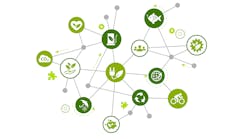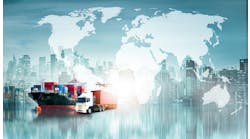Sustainability is one of the most overused terms in supply chain in recent history and can mean different things to different people. However, this does not take away its importance when it comes to assessing a supply chain.
Supply chains are transitioning away from traditional transactional functions, from focusing on a “lowest cost wins” principle to becoming more complex and strategic value networks. With the ever-increasing global integration through human migration and emerging technology, never have supply chains been so interconnected, cross-dependent and the haloed drivers of customer value.
The recent episodes of Brexit readiness and COVID-19 response have heightened the need for more resilience, while other events like climate change, modern slavery and Black Lives Matter have further underscored the need to promote transparency in global supply chains. One can argue that both resilience and transparency are just two sides of the same coin—better known as sustainability.
While literature is rich with definitions of supply chain sustainability, it is important to drive some amount of alignment when it comes to something as important as global supply chains bringing the people and planet together.
In basic terms, supply chain sustainability is a measure of a chain’s performance across social equity, economic and environmental factors, overlaid by the idea of industrial, natural, human and technological systems, working together to create a better world. This definition stops businesses from promoting one sustainability area at the cost of others, and helps build a more holistic approach to sustainability, which may be easier said than done otherwise.
Glass bottles or plastic bottles? Electric cars or gasoline-based cars?
The Internet is inundated with many such questions and there are always good and bad points for both sides. While the answers may differ considerably based on the scope of the supply chain being measured, one cannot disagree that the holistic impact of end-to-end supply chains needs to be judiciously measured.
For instance, while the never-ending piles of plastic bottles in our environment may seem somewhat like the devil’s gift to mankind compared to their glass cousins, it is important to also think about what happens during production, transport and recycling of either options.
Production of glass needs sand, which is one of the key reasons for our depleting riverbeds and seabeds, which is disrupting environments and exposing communities to flooding and erosion. The production of glass bottles is energy-intensive and accounts for 1% of total industrial energy use globally. What’s more, glass being heavier, it takes more energy (up to 600% more) to transport over the same distance as plastic. And then there are other considerations when it comes to after-use management and recycling. Plastic, however, has its own set of problems—begging a full assessment across the lifecycle of both products.
If this wasn’t enough, seldom do companies know their entire supply chain. With only 6% of firms confident of good supply chain visibility, it is still a difficult task to assess end-to-end supply chains. The fact remains that there is no easy answer to the sustainability question.
Making Commercial Sense of Sustainability
It wasn’t that long ago when sustainability was dividing business leaders, with multiple debates on its real commercial value. Many such discussions began in the marketing department, but were assessed mostly for costs alone. Moreover, many sustainability initiatives were either seen as a cost-cutting measure or merely a greenwash.
The business ecosystem in 2020 is quite different, with sustainability not just being a greenwash anymore. There are more examples today where customers have either reduced or even stopped buying products due to otherwise hidden issues like poor working conditions or even delayed supplier payments. There is an increasing focus on offering sustainably grown, processed and packaged products across all leading retail chains. NYU’s research suggests that that 50% of CPG growth from 2013 to 2018 came from sustainability-marketed products, clearly adding a growth lens to the discussion.
There are many emerging examples across sectors, supporting sustainability’s role in building and preserving brand and commercial value. However, there is still work to be done in bringing customers closer to the value chain, and making them a part of the overall sustainability journey.
Blueprint for Sustainability
While financial and operational models for economic sustainability have existed for a long time, not much work had gone into “cohesively” bringing together the social equity and environment side of equations. But organizations now have access to tools to help them start planning on the right lines.
Lifecycle sustainability assessment adopts a supply chain view to assess processes for environmental, social and economic impacts—for the entire lifecycle of a product or service—allowing companies to make decisions that have the maximum bearing on their sustainability footprint.
Sustainable development goals are a combination of 17 goals, including responsible consumption and production, sustainable communities, climate actions and more. The entire development agenda covers over 160 areas and is pragmatically linked to ISO standards, making it a hefty blueprint to plan upon.
While these are two of the many tools available, they present invaluable starting points to start defining a sustainability strategy for any supply chain.
Developing a Sustainability Strategy
Companies can adopt a basic six step process to kick start their sustainability journey:
1. Map your supply chain. Map your product information and cash flow from end to end—even cradle to grave.
2. Segment your supply chain. Segment your supply chain based on three dimensions: product/service, customers, and delivery mechanism. Each of these segments will vary in terms of process, performance and expectations.
3. Measure. Adopt one of the available sustainability tools to measure your sustainability footprint continuously and quantitatively for the various segments. This will involve working with your suppliers and customers.
4. Plan. Set targets and document them thoroughly—communicate your plans as part of your annual targets.
5. Educate. The success of your sustainability strategy will depend upon how well your employees, suppliers and customers are empowered to deliver the change, which will need a fair bit of investment in training.
6. Celebrate. Do not forget to revisit and celebrate the impact your plan has had on your supply chain.
Whether it’s avoiding a brand due to mistreatment of workers or insufficient transparency on use of unsustainable palm oil, or even a remote linkage to dubious funding or business processes, this new information age has made it very easy for customers to vote with their shopping carts and to switch brands. Sustainability reviews have an increasingly important role in building and preserving brand image and customer lifetime value.
It has never been more important to make an honest attempt on sustainability, and in order not to fail, it is important for businesses to consider their priorities and include sustainability as a part of their supply chain strategy.
So, when do you plan to review yours?
Gopal Iyer is supply chain delivery lead at procurement and supply chain consulting firm 4C Associates.



